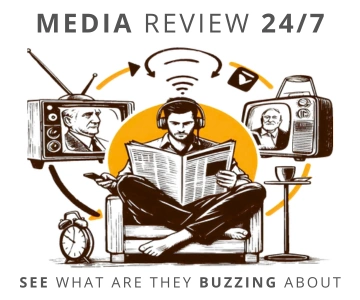 illustration: DALL-E
illustration: DALL-EMore and more consumers expect companies not only to be available everywhere and at all times but also to meet those expectations with the help of artificial intelligence. These are the conclusions of the Five9 2025 Customer Experience Report, which surveyed over 1,000 respondents from the US, Canada, and the United Kingdom. Companies that effectively use AI while maintaining a human touch will gain more than just fleeting attention - they’ll build lasting relationships.
The consumer wants convenience, not compromise
The Five9 survey shows that consumers don’t have a single favorite method of customer service contact - it all depends on the situation. As many as 59% of respondents said their choice of communication channel depends on the context, and for 60% the key factor is response time. This means companies must be flexible and present across various platforms - from chats to emails to traditional phone calls.
Most respondents - 86% - say they try to resolve the issue on their own before contacting support. Self-service is no longer a novelty; it`s becoming the standard.
| Consumer preferences | Percentage of respondents |
|---|---|
| Try to find a solution before contacting support | 86% |
| Choice of contact channel depends on situation | 59% |
| Fast response times are a priority | 60% |
This pushes brands to invest in omnichannel solutions. For example, a customer who starts a conversation with a chatbot wants to smoothly switch to a phone call if needed - without repeating information or waiting endlessly.
AI at the heart of customer experience
Artificial intelligence is no longer the future - it`s the present of customer service. As many as 72% of respondents in the Five9 2025 Customer Experience Report said they are open to AI-based interactions - provided they can quickly escalate to a human when needed.
On the other hand, 59% prefer an immediate chatbot conversation over waiting for an agent. Interestingly, over half (54%) believe generative AI will genuinely improve service quality.
- 72% of consumers accept AI if they can escalate to a human
- 59% prefer bots to waiting for a human agent
- 54% expect GenAI to improve service quality
- Main demands for AI: accuracy, intuitiveness, zero errors
- Customers expect AI not just to answer but to understand the context
But it`s not enough to deploy new technology. Customer trust is built through accurate algorithms, a clear interface, and quick access to human help. For example, an AI-powered booking system that assigns the wrong hotel room can ruin an entire trip. But if the customer gets fast support and a correction - they’ll trust the brand even more.
The human touch still matters
Although AI is becoming more present, human interaction remains crucial. A full 86% of respondents said a personal connection is more important than a fast response. The phone still dominates, especially in complex matters - 74% of consumers prefer a voice call when an issue is urgent or difficult.
| Preferred contact channel | Simple matters | Complicated or urgent |
|---|---|---|
| Phone | 56% | 74% |
| Chatbot or live chat | 31% | 15% |
| 10% | 7% |
This shows that technology cannot fully replace humans - it should support them. Agents still play a key role in building relationships, especially in critical moments. For many customers, a voice on the line is the only way to feel truly understood.
One bad experience and... the relationship is over
In a world where competition is just a click away, one mistake can cost a company a loyal customer. Forty percent of respondents said they stop doing business with a brand after a single bad interaction. What’s more, 95% share their bad experiences with friends or family.
The main sources of frustration are:
- Long wait times to reach customer service
- Being forced to use inconvenient channels (e.g., no phone option)
- Inconsistent service across different stages of contact
- No option to escalate issues quickly
Five9 analysts stress that these are not isolated incidents. Companies that don’t invest in personalization and fast support risk losing customers. For example, a bank customer stuck in a loop of automated voice prompts described the experience on social media. Within days, the post received thousands of reactions and comments, severely damaging the bank’s reputation.
The Five9 2025 Customer Experience Report, developed in collaboration with Zogby Analytics, shows that the future of customer service is not only advanced technology but, above all, the ability to listen and respond to individual needs.
COMMERCIAL BREAK
New articles in section Marketing and PR
Dance in the media mirror. Between culture, business and viral fame
KFi
Over 78,000 media pieces, 1.6 billion potential views, and 197,500 social media mentions-dance in Poland is no longer niche. With a combined media value exceeding PLN 800 million, it now outperforms MMA, handball, and hockey.
PR in Poland. Ranking of the largest public relations agencies 2025
KFi
The smallest teams often generate the most publications, and agencies outside Warsaw are increasingly capturing media attention. This unexpected distribution of power is one of the key findings from the 2025 PR Agency Ranking in Poland, developed by Widoczni and IMM.
Connected TV and borderless advertising. The ID5 report
KFi
Viewers are moving away from cable TV. And they are doing it en masse. Already 86% of Europeans watch content via Connected TV and global ad spend in this segment is set to double by 2028. The industry is undergoing a communication revolution.
See articles on a similar topic:
Contextual Advertising in Print Media. PBC Measured Its Effectiveness
BARD
Print advertising, when placed in the appropriate editorial context, attracts 67% more attention than ads in other sections, according to research conducted for Polskie Badania Czytelnictwa (PBC). Contextual ads hold the reader’s gaze longer and engage them more deeply.
Internet Subscriptions: Market Value, Development Trends, and... Risks
KrzysztoF
According to McKinsey & Company, the number of subscription users globally has increased by over 17% in the past year. A report from UBS Group AG indicates that the total value of the global subscription market will reach as much as $1.5 trillion by 2025. This is twice as much as in 2020!
When a Review Lies. The Growing Threat of Fake Opinions Online
KFi
Popularity of digital marketplaces rises, so does a less welcome trend: fake reviews. These manipulated opinions distort product rankings and mislead consumers, all while unfairly disadvantaging honest businesses. And despite regulatory efforts, the problem is far from solved.
How to reduce food waste? Packaging design matters
KFi
Researchers from China have proven that visual packaging elements and consistent messaging can be effective tools in the fight against global food waste. They published research results showing that designers and marketers can make a real difference.





























